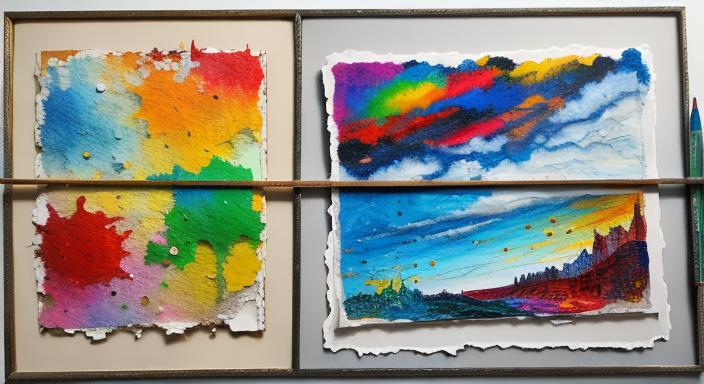Have you ever wondered how two artistic giants of the same era and movement could have such vastly different styles? The clash between Claude Monet and Edgar Degas has been a topic of fascination for art enthusiasts and historians alike. In this guide, we’ll explore the intriguing contrasts and similarities between these two French Impressionist masters, diving deep into their techniques, subject matter, and the personal dynamics that fueled their creative rivalry.

Understanding the Basics
Before we delve into the nitty-gritty, let’s address some common questions:
- What is Impressionism? Impressionism was a revolutionary art movement that emerged in the late 19th century, characterized by bold brushwork, vibrant colors, and a focus on capturing the fleeting effects of light and movement.
- How did Monet and Degas fit into this movement? While they were both pivotal figures in the Impressionist movement, their approaches couldn’t have been more distinct. Monet was the quintessential plein air painter, capturing the ever-changing landscape with his loose, expressive brushstrokes. Degas, on the other hand, was fascinated by the human figure, often depicting scenes from modern Parisian life, such as ballet dancers and café scenes.
Artistic Contrasts
Let’s explore the striking differences between these two titans:
- Subject Matter: Monet’s muse was nature itself – his canvases were alive with shimmering water lilies, haystacks, and sunlight-dappled landscapes. Degas, however, was drawn to the human form, often depicting ballet dancers mid-movement or candid scenes from everyday life.
- Technique: Monet’s brushwork was characterized by bold, visible strokes that blended into a cohesive whole when viewed from a distance. Degas, on the other hand, favored a more controlled, linear approach, often incorporating unusual perspectives and cropping techniques.
- Color Palette: Monet’s landscapes were a symphony of vibrant hues, capturing the ever-changing play of light on his subjects. Degas, however, favored a more muted, earthy palette, with occasional pops of color to highlight specific details.
Personal Dynamics
Beyond their artistic differences, Monet and Degas had a complex personal relationship that often fueled their creative fire. While they respected each other’s talents, they had vastly different personalities and approaches to art.
Monet was a gentle, introspective soul who found solace in nature, while Degas was known for his biting wit and sarcastic humor. Their clashing temperaments often led to heated debates and arguments, with each artist fiercely defending their artistic vision.
Despite their differences, there was a mutual respect and admiration that bound them together. Degas once famously quipped, “Monet is only an eye, but what an eye!” – a backhanded compliment that acknowledged Monet’s unparalleled talent for capturing the ephemeral beauty of nature.
Monet and Degas – Painting Value Comparison
| Artist | Painting | Year | Sale Price | Top Auction Price |
|---|---|---|---|---|
| Claude Monet | Water Lilies and Japanese Bridge | 1897-1920 | $54.1 million (1988) | Meules (Haystacks) – $110.7 million (2019) |
| Claude Monet | San Giorgio Maggiore at Dusk | 1908 | $71.4 million (1998) | Meules (Haystacks) – $110.7 million (2019) |
| Claude Monet | Nympheas (Water Lilies) | 1919 | $80.5 million (2008) | Meules (Haystacks) – $110.7 million (2019) |
| Edgar Degas | Petite Danseuse de Quatorze Ans (Little 14-Year-Old Dancer) | 1879-1881 | $14.6 million (1999 sculpture) | Danseuse (Dancer) – $41.6 million (1998 pastel) |
| Edgar Degas | Danseuses (Dancers in Blue) | 1890 | $37.0 million (2008) | Danseuse (Dancer) – $41.6 million (1998 pastel) |
| Edgar Degas | Danseuse (Dancer) | c.1890s | $41.6 million (1998 pastel) | Danseuse (Dancer) – $41.6 million (1998 pastel) |
As the table shows, works by Monet generally fetch higher prices than Degas at top auctions. Monet’s famous Haystacks series is particularly valuable, with one painting selling for $110.7 million in 2019 – a new record for his work at auction.
Degas’s most valuable works tend to be his pastel drawings and paintings of dancers, with his Dancer pastel drawing setting his record price of $41.6 million in 1998. His famous sculptor Little 14-Year-Old Dancer also sold for $14.6 million in 1999.
While their artistic styles differed, both Monet and Degas are titans of the Impressionist movement whose works demonstrate the immense value, significance and lasting impact of their revolutionary artistic visions.
Legacy and Influence
Today, the works of Monet and Degas remain among the most celebrated and influential in the art world. Their divergent styles and approaches have inspired countless artists, and their paintings continue to captivate viewers with their vivid depictions of light, movement, and the fleeting moments of everyday life.
Whether you’re a seasoned art aficionado or a curious newcomer, delving into the world of Monet and Degas is a journey that promises to delight, challenge, and inspire you.
So, what are you waiting for? Immerse yourself in the vibrant colors, bold brushstrokes, and artistic rivalry that defined these two giants of Impressionism.


